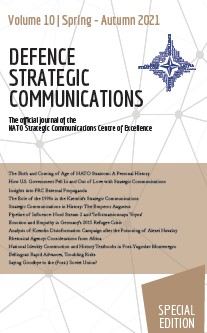ANALYSIS OF KREMLIN DISINFORMATION CAMPAIGN AFTER THE POISONING OF ALEXEI NAVALNY
ANALYSIS OF KREMLIN DISINFORMATION CAMPAIGN AFTER THE POISONING OF ALEXEI NAVALNY
Author(s): Nora Jansen, Diyana DobrevaSubject(s): Media studies, International relations/trade, Political behavior, Politics and communication
Published by: NATO Strategic Communications Centre of Excellence
Keywords: strategic communications; strategic communication; disinformation; disinformation campaign; Alexei Navalny; Russian state-owned media (RSOM); Kremlin;
Summary/Abstract: This article analyses the disinformation campaign launched by Russian state-owned media after the poisoning of Alexei Navalny, comparing its key elements with findings from discussions held at the NATO StratCom COE in 2016 and from relevant literature, to develop a better understanding of the Kremlin’s long-term pattern of communications that further its strategic objectives domestically and internationally. We systematically analysed the disinformation campaign both quantitatively and qualitatively using the ‘A2E model’, adapted from an analytical framework created in 2019 by the Transatlantic Working Group. We concluded that familiar strategies designed to neutralise Western criticism and ‘fog the news’, such as projecting multiple alternative narratives, flooding the media with large numbers of articles, and inviting pro-Kremlin ‘experts’ to comment, were still being employed in 2020. We show how Russian state-owned media generate narratives to debunk evidence, deny responsibility, discredit opponents, and distract domestic and international audiences—a ‘4D framework’ for disinformation. This research into the Kremlin’s strategic communications is timely and necessary as it reveals the Kremlin’s practice of using disinformation, not only in military contexts, which have been better studied, but also as analysed here, to cover an assassination attempt.
Journal: Defence Strategic Communications
- Issue Year: 10/2021
- Issue No: 10
- Page Range: 323-361
- Page Count: 39
- Language: English

